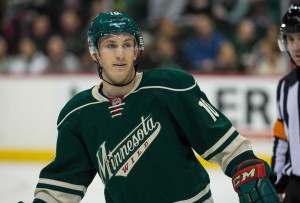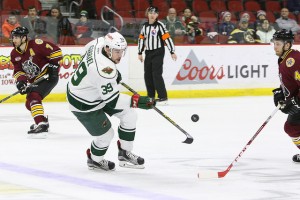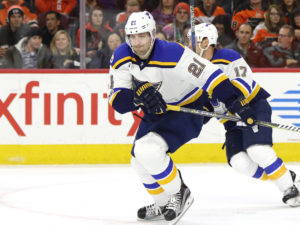The Minnesota Wild are in the midst of the most successful season in franchise history. The team sits first in the Central Division, first in the Western Conference and second in the NHL’s overall standings. They rank second in goals against, third in goals for and also lead the league with 10 players already reaching double digits in the goals column.
The Wild’s only clear-cut weakness, other than back-up goaltending, is the team’s fourth line centre and left wing positions. Head coach Bruce Boudreau has used somewhat of a trial-and-error approach recently as he attempts to solve the team’s fourth-line puzzle – a puzzle that remains unsolved.
Internal Options

Throughout the course of the 2016-17 season, a multitude of players have come up from the Iowa Wild to try their hand at becoming a fixture on Minnesota’s fourth line alongside veteran Chris Stewart. To date, not a single one of these hopefuls have taken their chance and run with it.
The team has tried Jordan Schroeder, Tyler Graovac, Zack Mitchell, Zac Dalpe, Christoph Bertschy, Teemu Pulkkinen, Kurtis Gabriel, Pat Cannone and Alex Tuch but all to no avail.
Schroeder has had his share of good moments and leads this group of try-outs in points. What hurts him is the fact that, at 5-foot-9, he’s not exactly your prototypical fourth-line energy generator and is easily pushed around.
Graovac is on the opposite end of the size spectrum, standing at 6-foot-5, but hasn’t exactly used that asset to his advantage. The big centre has been trying to play more of a finesse game rather than a grinding one and has been poor in the dot.
Tuch, the 18th overall pick in the 2014 draft, got his first taste of the NHL in February but just isn’t ready for full-time duty. A lack of urgency and pace were his biggest criticisms and will need to be improved upon before he makes Minnesota a permanent home.
Bertschy, Pulkkinen, Cannone and Mitchell can be grouped together in that they each have skills and scoring ability at the AHL level. The downside however is that all four have been unable to translate that talent to the NHL level thus far in their careers. Cannone was a good story of perseverance as he made his NHL debut this season at age 30. While he has certainly paid his dues in the minor leagues, he appears to be another in the long line of AHL stars who just don’t have that special something to make an impact at the NHL level.

Veteran forward Dalpe and checking winger Gabriel might be the most inclined from this group of internal candidates to see NHL action during the playoffs. Both players were in the lineup for Minnesota last season when they battled the Dallas Stars in the first round and didn’t look out of place. The downside though is that neither individual is an established NHL player and they provide next to no offense.
Ryan Carter signed a professional try-out agreement with Iowa this week as he attempts a comeback from injury. The veteran of 473 NHL regular season games had surgery to repair a torn labrum in his right shoulder just prior to the start of the season. Carter spent the last two years in Minnesota and could be an option for one of the fourth-line vacancies if he impresses before the end of the month.
A top team like Minnesota would prefer to have established playoff performers on their bench ahead of guys who can’t consistently crack an NHL lineup. Based on that fact alone, it should be a priority for the Wild to explore the trade market in order to complete their forward roster.
Potential Trade Targets
The Wild are in a prime position to be buyers at this season’s trade deadline. They have a deep lineup jam-packed with quality veteran players, they are experiencing success like never before and they also face the certainty of losing an impact player for zero return to the Vegas Golden Knights come June. Simply put, they are in win-now mode.
Wild management will be looking to bring in at least one quality veteran, preferably with significant playoff experience, for their bottom-six group of forwards. As a matter of fact, it would not be the least bit surprising if they brought in two capable bodies before March 1 has come and gone.
The emergence of Gustav Olofsson has suddenly given general manager Chuck Fletcher some added options and flexibility for trade. The Wild are eight deep on the blue line and that’s without counting second-year pro Mike Reilly. They could realistically use Reilly, Christian Folin or even long-time Wild defenceman Marco Scandella as bait to acquire one or two reliable forwards for their playoff run.

Big-bodied veteran centremen would be the primary target — players like Brian Boyle (6-foot-7, 243 pounds), Martin Hanzal (6-foot-6, 226 pounds) and Patrik Berglund (6-foot-3, 217 pounds). All three players have between 13 and 17 goals and between 22 and 24 points. Boyle would come the cheapest, Hanzal is the best on faceoffs and Berglund lays the most hits but all three are comparable and would fit in what the Wild are trying to accomplish. All three are also scheduled to become unrestricted free agents July 1.
Secondary targets would be grinding players in their mid-20s who like to lay the body, stir the pot and pump up their teammates with their physical play. Some players of this mould who could be available include Marcus Foligno, Antoine Roussel, Ryan White and Dmitrij Jaskin.
Foligno could be of particular interest. He ranks third league-wide in hits, has nine goals and is on an expiring contract.
Wild-Card Solution
Not to be forgotten is the fact that 19-year-old Joel Eriksson Ek could potentially return to North America before all is said and done in 2016-17. The defensively responsible rookie was loaned to the Swedish Hockey League back in November after dressing for nine games with the Wild. The 2015 first-round pick would be eligible to return to Minnesota once his SHL club is finished their season.

Eriksson Ek showed well in limited NHL action picking up five points and displaying poise beyond his years. The 6-foot-2 centre was even more impressive during the world juniors where he served as captain for Team Sweden and scored six goals and nine points in seven games.
Since returning to Farjestad, Eriksson Ek has registered 13 points in 19 games. That’s just two points shy of the 15 he racked up in 41 contests with the same team last season. Wild management have to be happy with the way this prospect’s development is tracking.
The only caveat is that if Eriksson Ek plays one more game for Minnesota, his entry-level contract kicks in and he’s one year closer to free agency. Even with that in mind, he represents a lot of what the Wild will be trying to acquire and it would not cost the team any assets to bring him back into the fold. He has size, maturity, a defensive acumen and a scoring touch to go along with the fact that he is familiar with the players, the coaches and the systems in Minnesota.
The Wild definitely have options when it comes to filling the vacancies in their bottom six. How they will choose to do it remains to be seen.